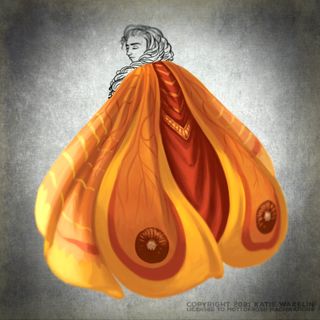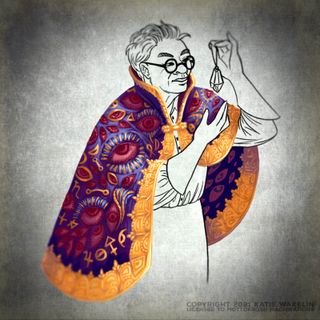How do you decide whether a found piece of loot makes it onto your character's inventory sheet? At early levels it might depend on its monetary worth, so you might end up carting around all the leather armors and shortswords of the brigands you just slew. But at later levels, more often than not, it depends on whether it is magical or not, and even then whether the bonus the items grants is better than that of a similar item you already own.
Here at Mottokrosh Machinations we think that is boring. And moreover, if a magical item is reduced to a number—or to casting a formulaic spell once a day—it is not really magical at all.
What we have are two problems. One, items are judged by their sell value or whether they're numerically better than a previous one. Two, over time, mundane items are displaced by their magical counterparts, and the inventories get flooded with so-called magic items. Any item that isn't magical won't even warrant a second glance from the characters, no matter how flavorful.

What if all items were potentially useful?
What if an item were judged by its story potential, regardless of whether it was semantically magical or not? Wouldn't it be great if everything you found, irrespective of your character's level, could be a new, fun option to create great situations at the table?
We've been thinking about this a lot, and have been experimenting with several ideas around this in our home games, playtests, and publications. And it boils down to two things: adjectives and tags.
Any item can be brought alive by one or two adjectives, and these adjectives can open up new possibilities. Take, for example, this item:
Broken pocket watch with slightly cracked glass, on an astonishingly long chain.
Of particular note here are the adverb plus adjective collocations "slightly cracked" and "astonishingly long". They denote possibilities without codifying them in rules. Instead they are meant to inspire the player to creativity. And it doesn't have to be extraordinary.
In a seasonal game of Hypertellurians with podcasting legends Liam and Matt from Mud & Blood, Liam's character had this very item, and one of the party nuns had fallen down a hole. Liam asked if perhaps the chain of his character's watch were long enough to reach down to her. Of course it was, since otherwise it would hardly be astonishingly long!
Similarly, one might imagine that slightly cracked glass (or any glass for that matter) could be broken into shards with very sharp cutting edges. Subtle ones at that, from something as delicate as a pocket watch.
This is what we mean when we say:
Natural Language Rules

It's one of the principles of Hypertellurians, but we certainly didn't invent it. In fact, the early RPGs were generally pretty rules light, and ad-hoc adjudication based on what made sense was expected of the GM. More recently, luminary and enfant sauvage Luka Rejec explained it well in his blog post.
That's the first pillar of exciting but otherwise seemingly mundane items. It doesn't always have to make perfect sense. How long is astonishingly long? At what point does it stretch suspension of disbelief? That's for your group to decide. But the important point is that the item is pregnant with possibility and applicability.
A simple wooden spoon will never make it onto a character's sheet, but an exceptionally bendy wooden spoon that whips back into shape like the limbs of a crossbow is a condiment thrower/catapult in the making.
We admit: coming up with these adjectives, after you used "surprising", "mysterious", and "astonishing" a few times is no easy feat. That's where the next part comes in:
Codified qualities with tags
You might call them properties, qualities, tags, or by any other name, but they boil down to this: small, discrete pieces of rules that you can attach to items (but also the effects of powers, spells, and other things, but for our purpose we concentrate on items).
Once again this is nothing new, of course. Heart-pounding game of oppressive authority fighting Spire uses weapon tags like "extreme range", "piercing", and "point-blank". Pathfinder has damage types like "bleed", "poison", and "elemental". Dungeon World has equipment tags like "awkward", "dangerous", and "slow".
Tags are great because they lend character to an item with but one or two words, and they're backed by rules where necessary. So let's take these tags and apply them generously to otherwise mundane items.
Here is a non-magical weapon as an example:
Manticore Mace. Looks like a fat, spiky scorpion tail with much more momentum than grace (light, brutal, unreliable).
It's a flavorful mace for sure, but it also has that interesting detail about momentum. How to use that? Perhaps it's great for smashing things, or maybe it's adept at being thrown, or just maybe you can get away with swinging it wildly to make that otherwise impossible jump? On top of that its tags declare it to be a light weapon (depending on your rule system that might mean being able to use DEX instead of STR to attack), brutal (some damage bonus), and unreliable (fun stuff happens if you miss).

Let's make clothes magically mundane
I mentioned in a podcast a while back that it was my goal to make every item your character finds potentially useful. To put my money where my mouth is, I naturally decided to write a book about cloaks, capes, and cowls.

Even in my hubris I realized that a product that niche, in an already niche section of the RPG world would be a hard sell, so I thought about tacking on an adventure. Well, things got a little out of hand, and now said book is in the works as a self-contained setting with numerous adventure locations in a realm of witchy couturiers.
The creative team consists of Katie Wakelin (art), Diogo Nogueira (maps & dungeons), and myself (writing), and I couldn't be more excited about it. And it's our first book properly dedicated to a slice of useful items, whether magical or not, which just so happen to be heavily fashion themed.
It's tentatively called Capes and Cloaks and Cowls and a Park. Yes, it takes place in a wizard's theme park. Which is inside a cloak. And since I've told you this much, I should probably also mention CLAMRIMS: Costumiers with Latent Arcane Magicks Refuge Initiative & Motivation Scheme. You see, the park's creator decided to use it as a refuge for seamstresses and tailors, who were (correctly) persecuted for being witches in his land. And then he vanished, and things got... complicated.
But that's another story, let's look at some of the new tags that this book introduces. Please note that all of this is work in progress, and might well change before publication. (It's been in playtest for a while now, but even after that editors will have a go at it.) And while we're at it, enjoy some sneak peeks of the art from the book, all by Katie, dotted throughout this post.
| Tag | Description |
|---|---|
| Balm | Soothes and calms nerves and emotions. |
| Gallium | Soft, tough, silvery liquid metal weave that hardens in the cold. |
| Impermeable | Liquid cannot pass through it. |
| Lithe | So unencumbering that is does not require an equipment slot. |
| Repellent | Entities of the specified nature do not willingly approach closer than a short distance, and if they're reasonably light gravity can't generally make them either. |
| Rigidulous | Only moves with force, not with momentum. |
| Sharded | Made of painstakingly connected or mounted hard pieces, like steel, mother of pearl, or obsidian. Functions as the armor indicated, but only takes half the usual slots, and looks killer. |
| Uniform | Forms or is part of a uniform, a recognizable outfit of a defined group, for good or ill. |
That's a small selection of tags that do not necessarily imply being magical, and yet open up any number of uses, not to mention the coolness factor of simply picturing a garment with them in your mind.
Improving the game
It's all about having more fun at the table ("table" being a metaphor for video chat meeting, more often than not these days), and incidentally our focus for this blog here too.
We're super excited about Capes and Cloaks and Cowls and a Park, and we're planning on bringing it to a Kickstarter near you (we've plans for a tasty and tactile physical book) before summer.
What about your games? Which items get the most traction with your players?
